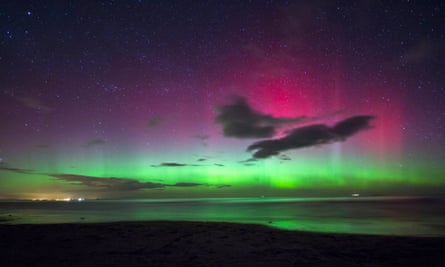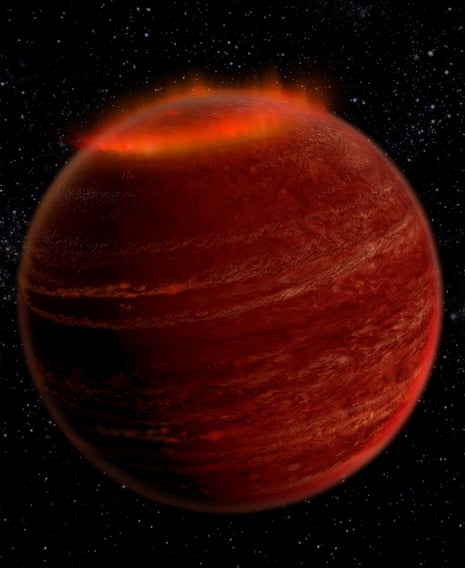The sky above a failed star in a distant constellation shimmers with a beautiful green and yellow aurora one million times brighter than the northern lights. The spectacular light show is the first confirmed aurora on a body outside the solar system, and the most powerful ever recorded.
Astronomers detected the celestial display when they trained some of the world’s most sensitive telescopes on a brown dwarf that lies 18 light years away in the constellation of Lyra. The aurora’s colourful streaks wave green and yellow when oxygen and sodium are battered by electrons in the brown dwarf’s atmosphere. The brightest light the telescopes picked up was from hydrogen, which glow redder than the eye can see.
“If you could stand there and look upwards, the aurora would appear one million times brighter than the northern lights,” said Stuart Littlefair, an astrophysicist at the University of Sheffield, who took part in the study.

The scientists’ observations solve a longstanding mystery in astronomy over why brown dwarves shine brightly and then dim again on a regular basis. The object they studied rotates on its axis once every two hours and flashes brightly in perfect synchrony. “We knew there was a spot on the surface, and as it appeared and disappeared, the brightness changed,” said Littlefair. “The question was: what is that spot?”
Researchers observed the brown dwarf with the National Radio Astronomy Observatory in New Mexico and the Hale telescope in San Diego. Whenever the brown dwarf lit up, the instruments picked up optical and radio signals that are emitted by aurora wherever they happen.
On Earth, the northern lights are driven by electrons that stream out of the sun into the planet’s magnetic field, which drives them towards the magnetic north pole, where they slam into atoms in the atmosphere. Similar displays are seen on other planets, and are particularly intense on Jupiter, where auroras driven by gases coming from its moon, Io, gleams with ultraviolet light.
Writing in the journal Nature , the international research team describe how they observed the aurora on a brown dwarf known as LSR J1835+3259. The object is the same size as Jupiter, but a staggering 80 times more massive. Despite its powerful aurora, the brown dwarf is 150,000 times too faint to be seen with the naked eye.
A brown dwarf is a giant ball of hot gas that is part way between a planet and a star. Stars are dense enough to generate their own intense heat by fusing hydrogen into helium. But brown dwarfs fall short of achieving this internal heat, and so cool and darken from the moment they are born. For this reason, they are often referred to as failed stars.
In spotting the aurora, scientists have notched up another feature that makes brown dwarves more like planets than stars. “They have cool atmospheres with clouds in, just like Jupiter, and now we see they have auroras, too,” says Littlefield. “It’s more evidence we should think of them as scaled-up planets more than scaled-down stars.”
Antoaneta Antonova, a senior author on the study at the University of Sofia in Bulgaria, said the discovery was the culmination of a decade of work into the nature of brown dwarves. She now plans to search for auroras on other objects outside solar system.
Jonathan Nichols, who studies the auroras of Jupiter and Saturn at Leicester University, said that the natural light displays could help astronomers find new planets beyond Earth. Planet hunters have spotted thousands of worlds circling faraway stars, but most are larger than Jupiter, and orbit very close to their parent stars.
“If you’re interested in discovering new planets, there is a gap in the types we can detect,” he said. “We are not very good at finding planets far out from their stars, but one way to do that might be to look for their auroras. This brown dwarf observation is an important first step towards that.”

Comments (…)
Sign in or create your Guardian account to join the discussion